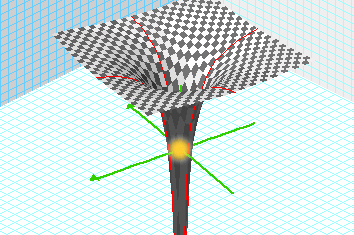Black Holes - Mother Stars
The Milky Way's Supermassive Core Sgr A*
Gravity well surrounding the Galactic core
Outside the supermassive core, the gravity potential field
varies inversely with radial distance (φG ~ 1/r) as shown above.
But inside, it varies approximately as r2, plateauing at the core's center.
The luminous cosmic ray emitting source at the center of our Galaxy is a celestial orb that is about 4.3 million times the mass of our Sun and the most massive object in our Galaxy. Currently it is seen to radiate about 20 million times as much electromagnetic energy as our Sun. By one estimate, it radiates most of its energy as cosmic ray electrons and protons, giving it a total luminosity 2.5 billion times that of the Sun (LaViolette, Subquantum Kinetics, 2012). Based on early radio observations, it was given the designation Sagittarius A*.
Stars orbit this body with velocities as high as 50% of the speed of light. Gas and dust also orbits Sgr A* but does not fall toward it. It is instead seen to be moving radially outward from this source. After long intervals, the matter/energy generation process within the Sagittarius A* becomes unstable and it explodes with intense luminosity. Such galactic core explosions pose a potential threat to our planet.


